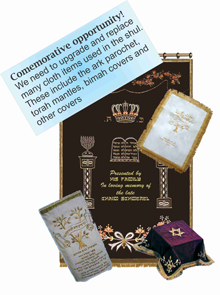Introduction to Shavuot
The Torah teaches that in the third month after departure from Egypt the children of Israel came to the wilderness of Sinai. Our sages teach us that the day was Rosh Chodesh Sivan. In the Torah the words “and Israel encamped” is written in singular – we learn from this that the people were united as one man with one heart. All the other encampments where marked by strife and contention.
The receiving of the Torah can only be merited when all Israel experience mutual love and brotherhood. On Shavuot we do not only commemorate the historical event of Mount Sinai, but we shal also strive to embody the values prevalent at this momentous occasion, namely, UNITY.
Laws and Customs relating to Shavuot and the month of Sivan
- The first twelve days of the month enjoy a special status, and are invested with a minor sanctity. The first day is Rosh Chodesh, and had the same status as every Rosh Chodesh. During the four days between Rosh Chodesh and the Festival of Shavuot, which falls on the sixth of the month, Moshe Rabeinu was engaged in preparing for the receiving of the Torah. On the sixth is Shavuot.(Outside the Land of Israel it falls on the sixth and seventh). From the seventh until the twelfth of Sican the special sacrifices offered by the festival pilgrims were brought. Therefore the first twelve days of Sivan are regarded as sanctified above the remainder of the month.
- In the year of the giving of the Torah, Rosh Chodesh Sivan fell on the first day of the week (according to Rabbi Yosi’s view – which is the accepted one), so that the Torah, which was given the Seventh of Sivan was given on Shabbat. For future generations, Shavuot is celebrated on the sixth of Sivan.
- During the three days prior to Shavuot a person should make a greater effort to learn Torah.
The Names of the Festival
The festival has 4 names.
1) The festival of Shavuot (Weeks)
2) The festival of Bikkurim (First fruits)
3) Atzeret
4) The festival of Matan Torah( Giving of the Torah)
- The first name, the festival of Shavuot is derived formt he seven weeks that are counted from Pesach until this festival, where te 6th day of Sivan is the 50th day after the beginning of the counting of the Omer. Others see the word Shavuot as the plural form of the Hebrew word for an oath, a Shevu’a, and link it to two oaths related to this date:
- The oath that the Children of Israel took at Mount Sinai, when all pledged, “We will do and we will hearken!”
- The oath that G-d took at Mount Sinai, where He promised not to exchange us, the Chosen people, for any other.
- The second name, Festival of Bikkurim, is given on account of the special offering of two loaves of bread brought on the Festival by the Priests on behalf of the whole population, to celebrate the wheat harvest. These are made from the early part of the wheat crop and known as bikkurim (Leviticus 23:17).
- Atzeret is the third name of the festival, and is the one used in the Talmudic literature, to connote that – just as Shemini Atzeret, the “eighth day”, marks the end of the seven days of the Sukkot Festival – so too Shavuot marks the end, as it were of the seven days of Pesach festival; and as we pointed out, the two festivals are linked by the counting of the Omer.
- The festival of Shavuot as the conclusion of Pesach is also the background of its fourth name: the festival of Matan Torah, the Giving of the Torah. This name stresses to us that the Exodus from Egypt was merely meant to be a preparation for the giving of the Torah at Mount Sinai. That is why in our prayers we speak of “This Festival of Shavuot; the time of the giving of the Torah”. Incidentally, one can ask why it is we speak of G-d’s action – the giving of the Torah – rather than of ours in the receiving of the Torah. Our sages tell us that there was a basic reason for this choice of verbs, for the Torah was given at a specific time by G-d, on the 6th Sivan, while receiving the Torah is something that each of us is obligated to do every day of our lives.
Reasons for the Using of Greens in Shuls on Shavuot
i. ‘In memory of the giving og the Torah which took place on a mountain verdant with green, we decorate our Synagogue and homes with green and fragrant flowers’.
ii. ‘Moshe Rabeinu was born on the seventh of Adar and he was hidden by his mother three months till, on the 6th Sivan, she put him in the river weeds. We therefore spread greens in memory of the miracle performed for Moshe Rabeinu.
Eating of Dairy Meals
The Talmud tells us that on Shavuot we must concern ourselves with physical pleasure as well as spiritual needs, for there are two statements in the Torah regarding the festivals; in on place we are told that they are “a convocation to the lord your G-d” (Deuteronomy 16:8), and in another they are referred to with the phrase, “they shall be to you a convocation” (Numbers 29:25). Thus the festivals are meant to serve both “G-d’s needs” as it were, and our own. From this, our sages deduced that the festivals should be “half for the Lord and half for you.”
It is an ancient custom, in terms of “taking care of our own needs,” to eat dairy meals during Shavuot. This can be either first night or first day. There are a number of reasons for this custom.
- In the Song of Songs, the Torah is compared to honey and milk, as we see in the verse, “Honey and milk are under your tongue” (Song of Songs 4:11). On the day which the Torah was received we try to eat these foods, to which the Torah was compared.
- The word ‘chalav’- milk- in gematria totals 40, and Moses was on Mount Sinai for 40 days and 40 nights when he went, on what is now Shavuot, to receive the Torah.
- The last reason is one of simple logic: until the Jews received the Torah, they were not required to keep their meat and dairy products separate, and they weren’t even aware of the rules governing this. Immediately after they received the Torah, the Jews realized that all their pots were not kosher , for they had used them for both meat and milk, etc. Thus until they could either make their pots kosher or get new ones, they had to live on fruits and vegetables and dairy products.
Akdamut:
The Piyut (liturgical poem) ‘Akdamut’ was composed by Rabbi Meir, the son of Rabbi Itzchak, who was Chazzan of the City of Worms. The sainted Rashi ( Rabbi Shlomo Itzchak ) was the resident of Worms, and tradition relates that Rabbi Meir was Rashi’s teacher.
The son of the author was slain for sanctification of G-d’s name during the Crusade of 1096. And he too sanctified the name of Heaven in a debate with Priests, which was forced upon him. In the debate the Priests attempted to persuade him to forsake his faith and to accept theirs. He answered appropriately and scorned them. He spoke to them, in strength and certainty, of the Creator’s power, of His love of Israel, of the excellence of Torah and the reward harbored for its devotees.
‘Akdamut is praise of the Creator of the Torah, and Israel. In many Jewish Communities throughout the world it became customary to chant it before the Torah reading on Shavuot. The words are accompanied by a melody which radiates a sense of majesty and triumph. In the community of Worms itself this custom was not accepted out of grief for the beloved author, whose death would be recalled to the people of Worms by the recitation of the Piyut.
TIKUN FOR THE NIGHT OF SHAVUOT:
Sages of the Kabalah prescribed an order of study for the entire night of Shavuot, which includes passages from the written Torah, the oral Torah, the Zohar as well as a summary of the six hundred and thirteen mitzvoth. This order of study (Tikun) was performed in accord with a passage in the Zohar which commends those who remain awake the night of Shavuot in anticipation of the hour of receiving the Torah; when the people of Israel became joined to the Torah and both became as one. Since the hour of the giving of the Torah is, as it were, the hour of wedding between Israel and the Torah, it is proper to be engaged in preparing the ornaments of the bride the previous night. It has also been suggested that the order of study for this night was intended to rectify the fault of those who first received the Torah – amongst whom there were many who overslept that night, and had to be awakened to receive the Torah.
“TORAH READING”
On the first day of Shavuot, the Torah reading is from the Book of Ruth on the second day of Shavuot is that it recalls the story of how Ruth embraced the Religion of Israel. Some other reasons are:
- The story of Rut took place during the beginning of the barley harvest – the same period as Shavuot.
- According to tradition, King David was born and died on Shavuot, and since David was a descendant of Ruth , we read Megillat Rut on Shavuot.
- ‘From her very birth, Ruth was worthly of accepting upon herself the yoke of mitzvoth’ and the very letters of her name bear witness to it. The letters for Ruth add up to six hundred and six which together with the seven Noahide laws add up to six hundred and thirteen; and there are 613 Laws in the Torah. (the Gaon of Vilna)
- Our fathers had the status of Converts when they accepted the Torah (in order to enter the covenant they were required to undergo circumsicion and immersion as is the case with Converts). In honour of Ruth who was a convert and became Mother of Israel’s Royal family we say ‘ When we received the Torah, we are all Converts’.







